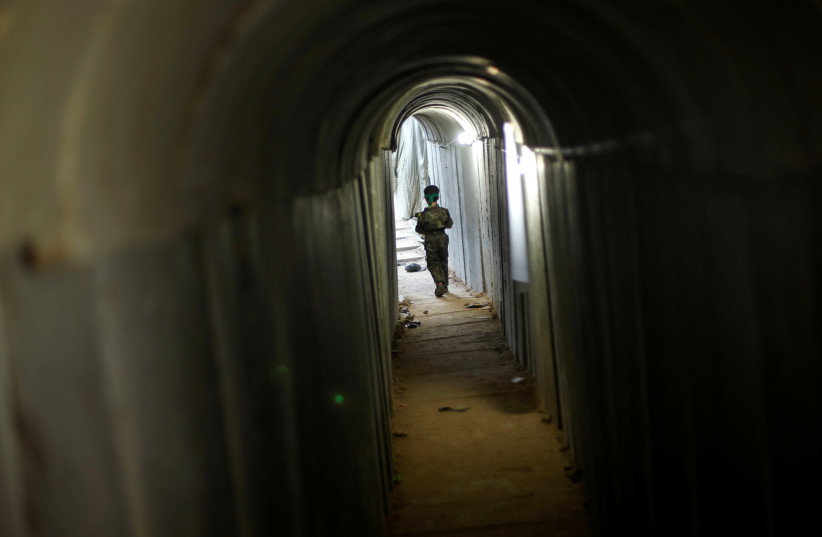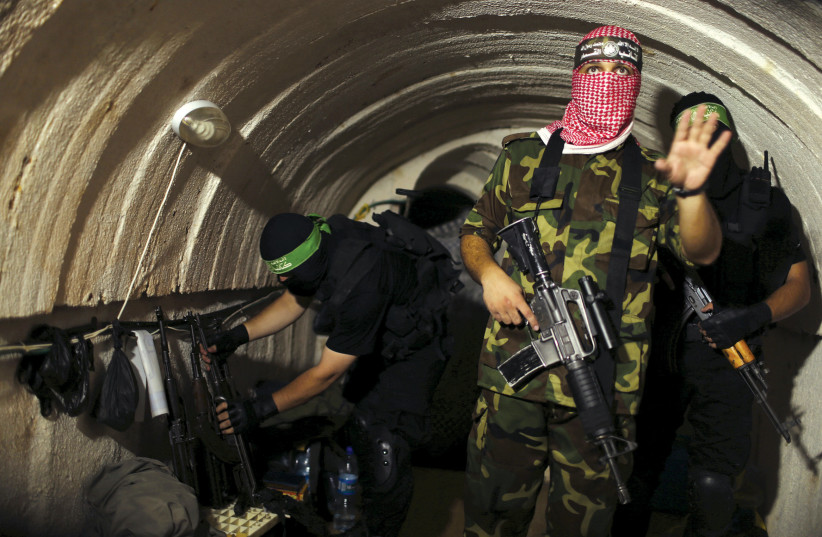After locating what they described as the entrance to a Hamas tunnel under an evacuated hospital in northern Gaza, Israeli army engineers filled the passage with exploding gel and hit the detonator.
The blast engulfed the building and sent smoke spewing out of at least three points along a nearby road in a district of the city of Beit Hanoun, surveillance footage showed.
"The gel spread out and exploded whatever they had been waiting for us in the tunnel," an army officer told reporters at a briefing at Zeelim Ground Forces Base in southern Israel.
Clearing the tunnels is an important part of Israel's military campaign against Hamas in the Gaza Strip in response to the Hamas terrorist group's deadly attack on southern Israel on Oct. 7.
When not using munitions to map out the bunkers, access shafts and tunnels which both sides say run for hundreds of kilometers (miles) under Gaza, the army opts for tracker robots and other technology operated remotely.
The officer could not be identified under the rules of the briefing, and declined to provide further details of below-ground combat which he said was a work in progress. He did not name the hospital in Beit Hanoun.
"I think there are other methods being developed," he said. "That is where creativity and innovation come in handy."

In Beit Hanoun, where his forces were operating, some gunmen had stormed the Israeli military from tunnel shafts and had been killed, he said.
Israel's policy, he said, was not to send personnel in the other direction to confront Palestinian fighters who would have a defender's advantage in narrow, dark, under-ventilated and collapsible passages with which they were familiar.
"We don't want to go down there. We know that they left us a lot of side-bombs (improvised explosives devices)," he said.
One such bomb, rigged to the cover of a tunnel-access shaft at ground level, had killed four special forces reservists last week.
Web of tunnels
Hamas has tunnels for attack, smuggling and storage, security sources say. Dozens of shafts can lead to each tunnel at depths of between 20 and 80 meters (65-260 feet).
Destroying a shaft is relatively easy and quick, the officer said, adding: "Any platoon can do it."
The Israeli military said last week that 130 shafts had been destroyed so far, but gave no figure for demolished tunnels.
The tunnels are harder to tackle. The officer said several ton of the exploding gel - on which he declined to give any technical details, other than to say it is brought in by truck - are required for every few hundred meters of tunnel.
After-action analysis is difficult. The officer said around half of the shafts in his Beit Hanoun operation zone had been destroyed, but acknowledged that these can be rebuilt.
"It's hard to say how many tunnels (are destroyed) because they are all connected," he said.
Hamas has denied using hospitals as cover for such tunnels. It has dismissed assertions by Israel that it has a command center under Gaza's biggest hospital, Al Shifa, which Israeli forces entered on Wednesday.

Efforts to avoid endangering hostages
Hamas took some 240 people back to Gaza as captives in the Oct. 7 attack in which about 1,200 people were killed, Israel has said. One of a handful of hostages released said she and at least two dozen others had been held in a tunnel.
The army officer said care was being taken not to endanger tunnels that may contain hostages.
"We sometimes get indications that this (a target) might be related to hostages. And then we know not to attack it unless we get an approval (that it is clear)," he said
Like much of northern Gaza, Beit Hanoun has been emptied of civilians, who fled south under orders from Israel as it sent in ground troops to try to wipe out Hamas.
"The only population left is the terrorists," the officer said, adding that sometimes a secondary explosion set off by a tunnel destruction blast "will bring down a building a few hundred meters away."
Hamas terrorists taken captive have provided Israel with intelligence on the tunnel network, he said, but this information has been limited.
"Most of them don't know about the whole city. But they know their own village, they know pretty well the tunnel system," the officer said.
The officer said it could take months to destroy Gaza's entire underground network.
"I think it's more complicated than the New York City subway," he said.
